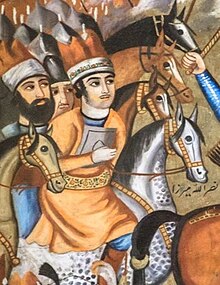Morteza Mirza Afshar (Persian: مرتضیمیرزا افشار) was an Afsharid prince and the son of Nader Shah of Persia, who was renamed Nasrollah Mirza (نصراللهمیرزا افشار) in honour of his role in the victory at Karnal. He proved to be a talented military leader and demonstrated his worth during the battle of Karnal by commanding the centre of the Persian army which defeated Sa'adat Khan's forces and captured his person.[1]
| Nasrollah Mirza | |
|---|---|
| Prince of Persia | |
 Nasrollah Mirza (detail) as depicted in the painting in the Chehel Sotoun commemorating the Battle of Karnal | |
| Born | Morteza Mirza 1724 Persia |
| Died | July 1747 (aged 23) Kalat, Khorasan, Afsharid Iran |
| Dynasty | House of Afshar |
| Father | Nader Shah |
| Mother | Gowhar Shad |
| Religion | Shia Islam |
He also held independent command during the Perso-Ottoman war of 1743-46 where he was tasked by Nader Shah of penetrating into Ottoman held Mosul province and engaging one of the two Ottoman armies whilst his father, Nader, marched against the other army at Kars in the north. He dealt a decisive blow to the Turkish and Kurdish forces around Mosul in the Battle of Mosul (1745).[2]
Early life
editAfter the death of Nader’s first wife, who was the elder daughter of Baba Ali Beg, the governor of Abiward, he married Gowhar Shad, the younger daughter of Baba Ali in the early 1720s. Morteza Qoli (also known as Nasrollah Mirza) was born in 1723 or 1724 as a result of this union.[3][4]
Death
editIn July 1747, Ali-Qoli Mirza (who later named himself "Adel Shah"), the nephew of Nader Shah Afshar, ascended to the Afsharid throne following a successful revolt against his uncle. In order to consolidate his power, he sent a force to the Kalat fortress with orders to kill all of Nader's issue, including Nasrollah Mirza.[5] Adel Shah's men slaughtered sixteen descendants of Nader, which included three sons of Nader, five sons of Reza Qoli Mirza and eight sons of Nasrollah Mirza. However, the other two sons of Nader, Nasrollah Mirza and Imam Qoli Mirza successfully escaped along with Nader's grandson Shahrokh, but they were soon captured near the city of Marv. Nasrollah Mirza and his brother were executed in Mashhad shortly after their capture in July 1747, while Shahrokh was spared. Shahrokh later reclaimed the Afsharid throne and ordered the execution of Adel Shah in 1748.[6]
See also
editReferences
edit- ^ "CAMBRIDGE HISTORY OF IRAN". iranicaonline.org. Retrieved 17 November 2015.
- ^ Axworthy, Michael (2015-10-29). The Sword of Persia. I.B.Tauris. ISBN 9780857721938. Retrieved 2015-11-17.
- ^ Avery 1991, p. 9.
- ^ Axworthy 2006, p. 182.
- ^ "NĀDER SHAH". Encyclopædia Iranica. 15 August 2006. Retrieved 15 September 2024.
- ^ Barati, András (2019). "The Succession Struggle Following the Death of Nādir Shāh (1747–1750)". Orpheus Noster 11/4: 44–58. Retrieved 15 September 2024.
Sources
edit- Avery, P.; Hambly, G. R. G.; Melville, C. (1991). The Cambridge History of Iran. Vol. 7. Cambridge University Press. ISBN 9781139054997. Retrieved 19 September 2024.
- Axworthy, Michael (2006). The Sword of Persia: Nader Shah, from Tribal Warrior to Conquering Tyrant (1st ed.). I.B. Tauris. ISBN 9780755612291. Retrieved 19 September 2024.
{{cite book}}: CS1 maint: ref duplicates default (link)